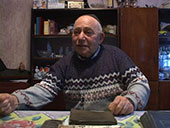
Moisei Katz grew up with six siblings. His father was a coachman for wood transportation. He attended heder until the age of thirteen. After his father was "drafted" as forced laborer in the Hungarian army, he continued his father's work as coachman. In 1944, he was deported to Auschwitz-Birkenau from the Iza ghetto. He was liberated from the Buchenwald concentration camp by the American army in 1945 and returned to Koshelovo, via Prague and Budapest. He moved to Khust in 1954 and worked in his profession as chauffeur.
Other Interviews:
Saving the Synagogue in KhustArrival in Prague
Liberation
Leaving For Home
On the Way Home
Khust, Ukraine
In this clip, Katz speaks about his experiences on his homeward journey, when he and his cousins met a fellow-Jew from his hometown Koshelovo.
After the liberation of Nazi camps by the American, British or Soviet armed forces in Spring 1945 a large number of Jewish survivors attempted to make their way back to their hometowns in Eastern Europe. Just like Moisei Katz, who was among the thousands of Carpatho-Ruthenian Jews who returned to southwestern Ukraine. The region of Transcarpathia was officially annexed to the Soviet Union in June 1945.
Those lucky enough to find a close or distant relative restarted their lives in postwar Transcarpathia with them and often decided together how to deal with the new Soviet reality. Jewish returnees, who were not lucky enough to encounter a family member or relative in their hometowns, looked for Jewish or non-Jewish friends in order not to have to face reality alone and to arrange for a familiar setting. Katz remembers the historical moment in this clip.
View map to follow the trajectories of Carpatho-Rusiyan Jews back to Transcarpathia.
